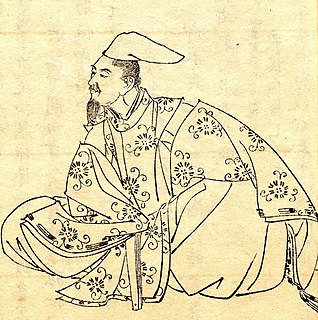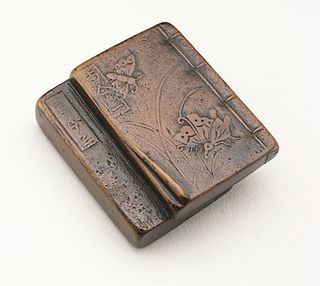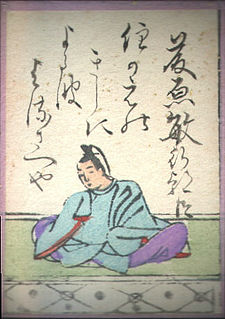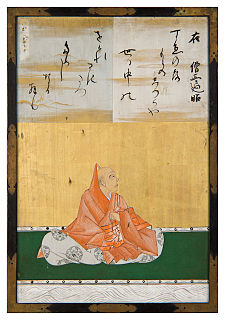
Ki no Tsurayuki was a Japanese author, poet and courtier of the Heian period. He is best known as the principal compiler of the Kokin Wakashū, also writing its Japanese Preface, and as a possible author of the Tosa Diary, although this was published anonymously.

Japanese poetry is poetry of or typical of Japan, or written, spoken, or chanted in the Japanese language, which includes Old Japanese, Early Middle Japanese, Late Middle Japanese, and Modern Japanese, and some poetry in Japan which was written in the Chinese language or ryūka from the Okinawa Islands: it is possible to make a more accurate distinction between Japanese poetry written in Japan or by Japanese people in other languages versus that written in the Japanese language by speaking of Japanese-language poetry. Much of the literary record of Japanese poetry begins when Japanese poets encountered Chinese poetry during the Tang dynasty. Under the influence of the Chinese poets of this era Japanese began to compose poetry in Chinese kanshi); and, as part of this tradition, poetry in Japan tended to be intimately associated with pictorial painting, partly because of the influence of Chinese arts, and the tradition of the use of ink and brush for both writing and drawing. It took several hundred years to digest the foreign impact and make it an integral part of Japanese culture and to merge this kanshi poetry into a Japanese language literary tradition, and then later to develop the diversity of unique poetic forms of native poetry, such as waka, haikai, and other more Japanese poetic specialties. For example, in the Tale of Genji both kanshi and waka are frequently mentioned. The history of Japanese poetry goes from an early semi-historical/mythological phase, through the early Old Japanese literature inclusions, just before the Nara period, the Nara period itself, the Heian period, the Kamakura period, and so on, up through the poetically important Edo period and modern times; however, the history of poetry often is different than socio-political history.
Helen Craig McCullough was an American academic, translator and Japanologist. She is best known for her 1988 translation of The Tale of the Heike.
The Shokukokin Wakashū is a Japanese imperial anthology of waka; it was finished in 1265 CE, six years after the Retired Emperor Go-Saga first ordered it in 1259. It was compiled by Fujiwara no Tameie with the aid of Fujiwara no Motoie, Fujiwara no Ieyoshi, Fujiwara no Yukiee, and Fujiwara no Mitsutoshi; like most Imperial anthologies, there is a Japanese and a Chinese Preface, but their authorship is obscure and essentially unknown. It consists of twenty volumes containing 1,925 poems.

Fujiwara no Toshiyuki was a middle Heian waka poet and Japanese nobleman. He was designated a member of the Thirty-six Poetry Immortals and one of his poems is included in the famous anthology Hyakunin Isshu.

The Rokkasen are six Japanese poets of the mid-ninth century who were named by Ki no Tsurayuki in the kana and mana prefaces to the poetry anthology Kokin wakashū as notable poets of the generation before its compilers.
The Nijūichidaishū are Japan's twenty one imperial collections (chokusenshū) of waka poetry written by noblemen. The following texts listed in chronological order constitute the Nijūichidaishū:
Ariwara no Motokata was a Japanese waka poet of the early Heian period.
The kana preface to the Kokin Wakashū is one of the two prefaces to the tenth-century Japanese waka anthology, the Kokin Wakashū. It was written by the poet/editor Ki no Tsurayuki. It is also known in English as the Japanese preface, distinguishing it from Ki no Yoshimochi's Chinese preface (mana-jo). It was the first serious work of poetic criticism on the waka style, and is regarded as the predecessor of later karon works.
The chokusen wakashū (勅撰和歌集), also shortened to chokusenshū (勅撰集), were imperially-commissioned Japanese anthologies of waka poetry. They numbered 21 in total.
Aishōka (哀傷歌) is a category of waka poetry. Loosely translated, it refers to "laments", but the precise meaning varied over the centuries. Originally it appears to have referred specifically to laments for the dead, but later came to include Buddhist poems on impermanence and even some love poems.







